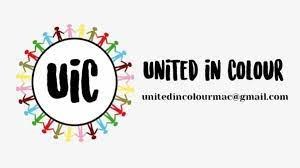United in Colour
United in Colour (UIC) is a collective of undergraduate and graduate Black, Indigenous, and racialized students who seek to create safer, more inclusive pedagogical spaces by providing both support to students of colour and advocacy to the university to improve the campus climate. As a coveted space, not afforded to every school or discipline, United in Colour provides students with sources of reprieve, guidance, support, and community in the sea of isolation that academia often quickly becomes for racialized students. In sharing stories and lived experiences of harm in the classroom and on campus, a temporary source of healing and understanding begins to form amongst a handful of students that can evolve into a site of sisterhood, brotherhood, family, and community.
Through seeking to extend this collective solidarity and support to every crux and corner of the academy, United in Colour has embarked on various formal and informal projects since its inception to collect the narratives and perspectives of racialized students. In 2019, UIC partnered with Dr. Ameil Joseph and the MacPherson Institute to document, explore, and mobilize the stories and experiences of students of colour that have repeatedly echoed in the halls of McMaster University. It was our goal to shift away from a mere collection of these stories to tangible, informed actions that result in material changes enhancing and promoting student experience and learning. These stories need to be heard, recognized, and taken up by stakeholders and people of power within dominant/majoritarian pedagogical practices and structures to create tangible and instrumental change, which was the core inspiration in the production of our project. From this partnership and these shared reflections, Learning in Colour was created.
What is shared amongst students of colour is the common understanding that these experiences are not siloed within individual departments, faculties, or university campuses; rather, this is a shared concern across academic institutions on a broader scale. Further, students have voiced these concerns, experiences, and insights for decades; they have been documented, investigated, and proven by student advocacy efforts (e.g. United in Colour, McMaster Womanists, the Pride Community Centre, the Women and Gender Equity Network, etc.), student-faculty collaborations (e.g. the Race, Racism, and Racialization [R3] Working Group of the President’s Advisory Committee on Building an Inclusive Community [PACBIC], the RACE Report, this project, etc.), and research reports, articles, and roundtable discussions.
These narratives can no longer sit in the shadows while the continuous effects of racism within university teaching continue to flourish. There is a strong need for change and a shift in responsibility and accountability. Bringing these narratives and stories to light is a necessary precursor to disrupting the foundation of systemic racism that academic institutions are built on, which United in Colour continues to centre in their work.
About Learning in Colour
Emerging from United in Colour's partnership with the MacPherson Insitute, Learning in Colour serves as a medium for knowledge mobilization and translation of the major findings of the research project. Specifically, with the support of the MacPherson Institute's Student Partners Program and the McMaster Okanagan Charter's Special Project Funding, we conducted a focus group with Black, Indigenous, and racialized students at McMaster University to explore their perspectives, experiences, and recommendations for enhancing student safety in the classroom and on campus more broadly. To supplement this work and produce a fulsome resource, we also drew upon previously collected data derived from former UIC-led projects, including Roché Keane's RACE Report and Glenda Vanderleeuw's Suggestion Box in the School of Social Work, and existing literature on the subject.
Learning in Colour consolidates information, recommendations, and resources about creating safety in the classroom and within the institution that could be integrated into a variety of course outlines and formats across the university. It is important to recognize that the content of this site centres and is informed by the experiences and suggestions of racialized students from our study and from the work of those who came before us.
The content of the site is organized as follows:
- Background about the project, collaborators, United in Colour, and context leading to the project (you are here right now!),
- Core themes identified by racialized students in our study about their experiences on campus,
- Guidance for instructors and TAs about how they can make their classroom spaces safer and more inclusive,
- Guidance for student peers and allies about how they can make their classes safer and more inclusive,
- Guidance for the academic institution about what can be done to make campus safer and more inclusive,
- Guidance and supports for racialized students about how they can support each other, engage in self-advocacy, connect with on- and off-campus resources, and navigate complaint resolution, and
- Resources for learning more and getting involved.
NOTE: This website may disrupt the way you have been socialized to think, feel, interact, identify, teach, and delegate. It may bring about feelings of fragility, discomfort, anger, resentment, and/or confusion. However, moving through and reflecting on the content and the emotions that may arise is a necessary modality that can better facilitate critical reflection and, ultimately, critical allyship and solidarity. So we invite you to begin your journey to institutional and pedagogical allyship because, as the pedagogical pendulum continues to swing in hopes of creating inclusion, safety, and change, so does the academic future of students of colour. Your consideration and acknowledgement of racial dynamics and tensions in the classroom and within pedagogy at large can offer much-needed balance. Welcome to Learning in Colour!
Partners, Collaborators, and Funders

United in Colour
Dr. Ameil Joseph
Dr. Chris Sinding
Glenda Vanderleeuw
Roché Keane
Fatemah Shamkhi
Valerie Nwaokoro
Ange Bitwayiki
Celine Freud
Devon Mordell
James Laforet
MacPherson Institute
McMaster Okanagan Charter
McMaster School of Social Work